A Git User's Guide to Mercurial Queues
Posted on August 10th, 2010.
I've been using Mercurial Queues more and more lately. At the last Mercurial sprint Brendan Cully said something that made me realize that MQ behaves very much like a souped-up version of git's index.
I wanted to write a blog post about the similarities between the two concepts so that git users could understand Mercurial's MQ extension a bit better and see how it can take that concept even further than git does.
This post is not intended to be a guide to MQ's day-to-day commands — it's simply trying to explain MQ in a way that git users might find more understandable. For a primer on MQ commands you can check out the MQ chapter in the hg book.
- Git Basics
- Mercurial Basics
- Using MQ with a Single Patch
- Using MQ with Two (or More) Patches
- Multiple Patch Queues
- Versioned Patch Queues
- Problems with MQ
Git Basics
Let's take a few moments to review how git works so we're all on the same page with our terminology.
When you're working with a git repository you have three "layers" to work with:
- The working directory
- The index
- The git repository
You use git add to shove changes from the working directory into the index
and git commit to shove changes from the index into the repository:
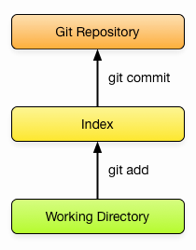
This is a very powerful model because it lets you build your changesets piece-by-piece and commit them permanently only when you're ready.
Mercurial Basics
With basic, stock Mercurial you only have two "layers" to work with:
- The working directory
- The Mercurial repository
You use hg commit to shove changes from the working directory into the
repository:
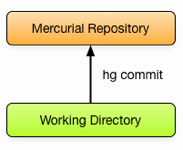
This model doesn't give you as much flexibility in creating changesets as git's does. You can use the record extension to get closer, but it's still not the same.
Let's take a look at MQ to see how it can give us everything git's index does and more.
Using MQ with a Single Patch
The most basic way to use MQ is to create a single patch with hg qnew NAME.
You can make changes in your working directory and use hg qrefresh (or hg
qrecord) to put them into the patch. Once you're done with your patch and
ready for it to become a commit you can run hg qfinish:
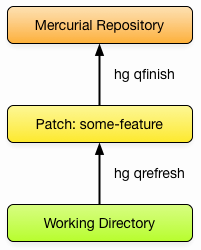
This looks a lot like the diagram of how git works, doesn't it? MQ gives you an "intermediate" area to put changes, similar to how git's index works.
Using MQ with Two (or More) Patches
This single "intermediate" area is where git stops. For many workflows it's enough, but if you want more power MQ has you covered.
MQ is called Mercurial Queues for a reason. You can have more than one patch in your queue, which means you can have multiple "intermediate" areas if you need them.
For example: say you're adding a feature that requires some API changes to your
project. You'd like to commit the changes to the API in one changeset, and the
changes to the interface in another changeset. You can do this by creating two
patches with hg qnew api-changes; hg qnew interface-changes:
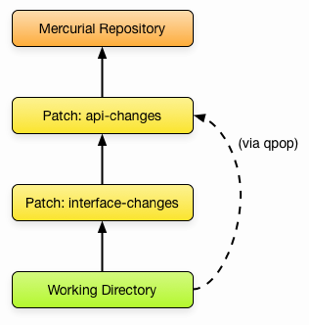
You can move back and forth between these patches with hg qpop and hg
qpush. If you're working on the interface and realize you forgot to make
a necessary change to the API you can:
hg qpoptheinterface-changespatch to get to theapi-changespatch.- Make your API changes.
hg qrefreshto put those changes into theapi-changespatch.hg qpushto get back to work on the interface.
Using multiple patches is like having multiple git indexes to store related changes until you're ready to commit them permanently.
Multiple Patch Queues
What happens when you want to work on two features, each with two patches, at the same time? You could simply create four patches and let the second feature live on top of the first, but there's a better way.
Mercurial 1.6 (I think) added the hg qqueue command, which lets you create
multiple patch queues, each one living in its own directory. That means you
can create a separate queue (with its own set of patches) with hg qqueue -c
NAME for each feature:
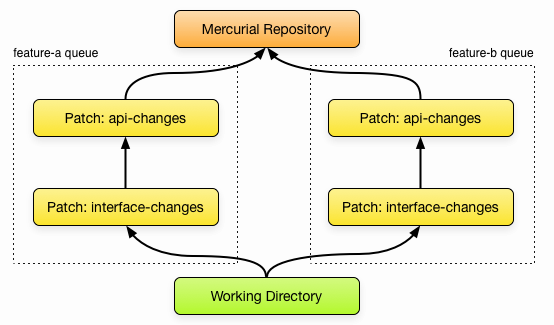
You can switch patch queues with hg qqueue NAME. This gives you multiple
sets of "intermediate" areas like git's index to work with. This is probably
not something you'll need very often, but it's there when you do need it.
You can see that MQ is already quite a bit more flexible than git's index, but it has one more trick up its sleeve.
Versioned Patch Queues
Let me prefix this section by saying: "You might think you need to use versioned patch queues, but you probably don't." Versioned queues can be tricky to wrap your head around, but once you understand them you'll realize how powerful they can be.
Let's pause a second to look at how MQ actually stores its patches.
When you create a new patch with hg qnew interface-changes Mercurial will
create a patches folder inside the .hg folder of your project. Your new
patch is stored in a file inside that folder (along with some other metadata
files):
yourproject/
|
+-- .hg/
| |
| +-- patches/
| | |
| | +-- api-changes
| | +-- interface-changes
| | `-- ... other MQ-related files ...
| |
| `-- ... other Mercurial-related files ...
|
`-- ... your project's files ...When you create a new patch queue with hg qqueue -c some-feature Mercurial
creates a completely separate patches-some-feature folder in .hg:
yourproject/
|
+-- .hg/
| |
| +-- patches/
| | |
| | +-- api-changes
| | +-- interface-changes
| | `-- ... other MQ-related files ...
| |
| +-- patches-some-feature/
| | |
| | +-- api-changes
| | +-- interface-changes
| | `-- ... other MQ-related files ...
| |
| `-- ... other mercurial-related files ...
|
`-- ... your project's files ...These folders are normal filesystem folders. The patches inside them are plain-text files.
This gives them a very important property:
They can be turned into Mercurial repositories to track changes.
Once you understand what this means, you should have several "oh my god" moments where you realize several very interesting things:
- Not only can you have multiple sets of "intermediate" areas to work with, you can version them to keep track of the changes!
- You can share queues with other people with Mercurial's vanilla push/pull commands.
- You can collaborate with other people and merge your changes to these "intermediate" areas with Mercurial's vanilla push/pull/merge commands.
- You can
hg servethese patch repositories so other people can see what your patches look like before they've been permanently committed to your project's repository.
Versioning patch queues means you can end up with a (hard to read) diagram like this:
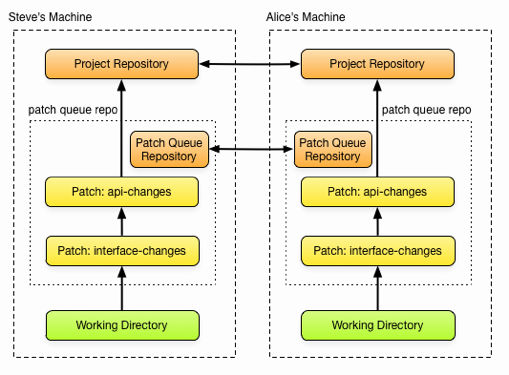
To facilitate working with versioned patch queues all Mercurial commands come
with a --mq option to apply the command to the queue repository instead of
the current one (so you don't need to cd to the queue repository all the
time).
Versioning patch queues is an incredibly powerful concept, and most of the time you won't need it, but it's nice to have it when you do.
It's also nice to know that BitBucket has special support for version patch queues.
Problems with MQ
Despite how powerful MQ is (or perhaps because of it) it has some problems. Most could be fixed if someone had a week or two to spend on it, but so far no one has stepped up.
I'd do it if I could afford to take a week away from full-time/freelance work, but I can't right now. If you want to be the hero of at least one MQ user (me) here's what sucks about MQ:
- There's no easy way to pull changes out of an MQ patch.
- There's no easy way to split an MQ patch into two patches (the current
horrible "workaround" is to empty the current patch,
hg qrecordpart one, andhg qnewto make a new patch with part two). - You can't pop a patch once you've made changes in your working directory. You need to shelve the changes, pop the patch, and then unshelve the changes.
In addition there's another MQ-related change that would be very, very nice:
- Refactor the record extension and put it into core Mercurial, so that
hg qrecordcould be used without an extra extension (and we could havehg commit --interactive).
If someone takes the time to fix these problems I'll love them forever. Until then we're stuck with the powerful-but-sometimes-clumsy MQ interface.
Hopefully this post has given git users (and Mercurial users) an idea of how powerful MQ can be. If you have any questions please find me on Twitter and me know!